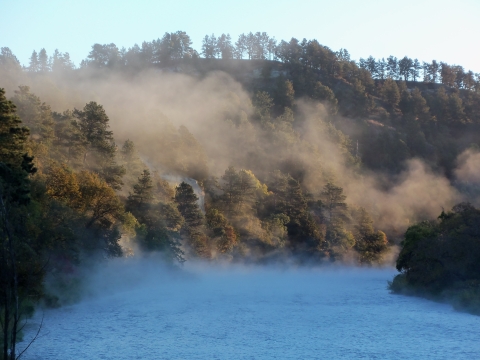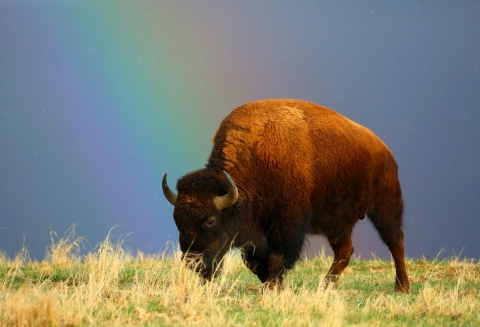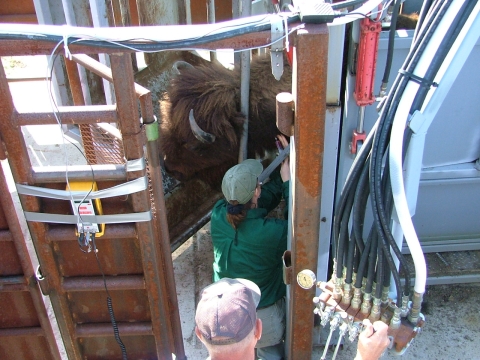Visit Us
Fort Niobrara provides numerous recreational opportunities to thousands of visitors every year. During your visit, you can view the unique geology and diverse wildlife and plants whether driving, hiking, and especially river floating. Nine miles of the Niobrara National Scenic River wind through the Refuge. Below the Cornell Dam, 5 of those miles are open to the public to launch their own kayak, canoe, or tube. Floating the river is one of the best ways to experience Fort Niobrara's wilderness area wilderness area
Wilderness areas are places untamed by humans. The Wilderness Act of 1964 allows Congress to designate wilderness areas for protection to ensure that America's pristine wild lands will not disappear. Wilderness areas can be part of national wildlife refuges, national parks, national forests or public lands managed by the Bureau of Land Management.
Learn more about wilderness area . The wilderness area is just shy of 5,000 acres of untrammeled land where only the plants and animals live.
You can learn more about wildlife and their habitats by stopping at kiosks and the Visitor Center on the Refuge. The Visitor Center is open Monday - Friday, 8-4 PM, excluding federal holidays
Location and Contact Information
About Us
Fort Niobrara National Wildlife Refuge is 19,131 acres and is located along the Scenic Niobrara River in north-central Nebraska. Fort Niobrara was established by Executive Order in January, 1912 as a “preserve and breeding ground for native birds.” An unusual mix of topography, soils, and rock formations along with differing exposures to sun, wind, and moisture creates a rich diversity of plants and animals. Deciduous forests and riparian riparian
Definition of riparian habitat or riparian areas.
Learn more about riparian wetlands border the river; coniferous forests grow on drier hillsides and canyon slopes; and mixed grass prairie is found on hard tablelands north of the river and sand dunes to the south. Furthermore, the unusual, and unique assemblage of plant communities currently present at the Refuge (Sandhills Prairie, Mixed Prairie, Rocky Mountain Coniferous Forest, Eastern Deciduous Forest, and Northern Boreal Forest) support a rich diversity of wildlife generally unchanged from historic times. Under the Wilderness Act of 1964, a 4,635-acre portion of Fort Niobrara was designated a Wilderness Area in 1976; a portion of the Niobrara River through the Refuge was designated a National Canoe Trail by Congress in 1982; and, in 1991, a 76 mile stretch of the Niobrara River including the River through this Refuge was designated Scenic under the National Wild and Scenic Rivers Wild and Scenic Rivers
The Wild and Scenic Rivers Act of 1968 established the National Wild and Scenic Rivers System, and authorizes Congress to preserve certain rivers with outstanding natural, cultural and recreational values in a free-flowing condition for the enjoyment of present and future generations. The act is notable for safeguarding the special character of these rivers, while also recognizing the potential for their appropriate use and development. The act encourages river management that crosses political boundaries and promotes public participation in developing goals for river protection.
Learn more about Wild and Scenic Rivers Act.
What We Do
Wildlife conservation is at the heart of the National Wildlife Refuge System. It drives everything on U.S. Fish and Wildlife Service lands and waters managed within the Refuge System, from the purposes for which a national wildlife refuge national wildlife refuge
A national wildlife refuge is typically a contiguous area of land and water managed by the U.S. Fish and Wildlife Service for the conservation and, where appropriate, restoration of fish, wildlife and plant resources and their habitats for the benefit of present and future generations of Americans.
Learn more about national wildlife refuge is established to the recreational activities offered to the resource management tools used. Using conservation best practices, the Refuge System manages Service lands and waters to help ensure the survival of native wildlife species.
At Fort Niobrara National Wildlife Refuge our focus is to conserve native birds, including their habitat for current and future generations to enjoy. Refuge staff use a variety of habitat management tools including prescribed burning, rotational grazing, and invasive plant management to meet management goals.
Our Organization
The mission of the National Wildlife Refuge System is to administer a national network of lands and waters for the conservation, management and restoration of the fish, wildlife and plant resources and their habitats within the United States for the benefit of present and future generations of Americans.
The Refuge System protects some of the country’s most beautiful wild places and the fish and wildlife that rely on them: prairies of the heartland, teeming with native pollinators and bison; hardwood forests of the Southeast, a source of regional and cultural pride; desert Southwest landscapes, home to vibrant and rare plant communities that draw new life during the summer monsoon season. The Refuge System also conserves waterways that give life to all of them — critical ecosystems along rivers, streams, wetlands, coasts and marine areas.
The National Wildlife Refuge System lands and waters serve a purpose distinct from that of other U.S. public lands: Wildlife conservation drives everything on national wildlife refuges, from the purposes for which each refuge was established, to the recreational activities offered, to the resource management tools used.
Each Refuge is established to serve a statutory purpose that targets the conservation of native species dependent on its lands and waters. All activities on those acres are reviewed for compatibility with this statutory purpose. Fort Niobrara NWR employs grazing, prescribed fire, wildlife monitoring, and more to attain the mission of the National Wildlife Refuge System. We also offer mission-compatible recreational opportunities such as fishing, hunting, wildlife viewing, hiking and more.
Our Species
Fort Niobrara National Wildlife Refuge was established “... as a preserve and breeding ground for native birds.” Many National Wildlife Refuges were established for migratory bird conservation; however, Fort Niobrara includes the conservation of non-migratory native bird species such as prairie chickens and sharp-tailed grouse. Fort Niobrara Refuge is also home to many other species including deer, coyote, badger and bison.
Get Involved
The Refuge routinely partners with state agencies, universities, and non-governmental organizations to complete projects. These partnerships typically benefit refuge habitats, infrastructure, recreational opportunities, higher education, and the local economy. From its start in 1903, the National Wildlife Refuge System has owed its very existence to concerned citizens eager to protect America's natural resources. We welcome volunteers! The Sandhills Prairie Refuge Association is a Friends Group established to support the refuges of the Sandhills NWR Complex.
Projects and Research
Inventory and monitoring projects are conducted to and support Refuge purposes; further understand the wildlife and plant communities, and inform management decisions for diversity of species and environmental health. This includes federally threatened and endangered species. Perhaps the most interesting project on the Refuge is the bison program. Bison are rounded up each year to manage the population. During the fall roundup, staff monitor herd health and genetics of individuals through the collection of blood and hair samples. For the health of the habitat the bison population at the Refuge stays around 350 individuals, our excess animals are donated to tribes. This event is open for public viewing!







